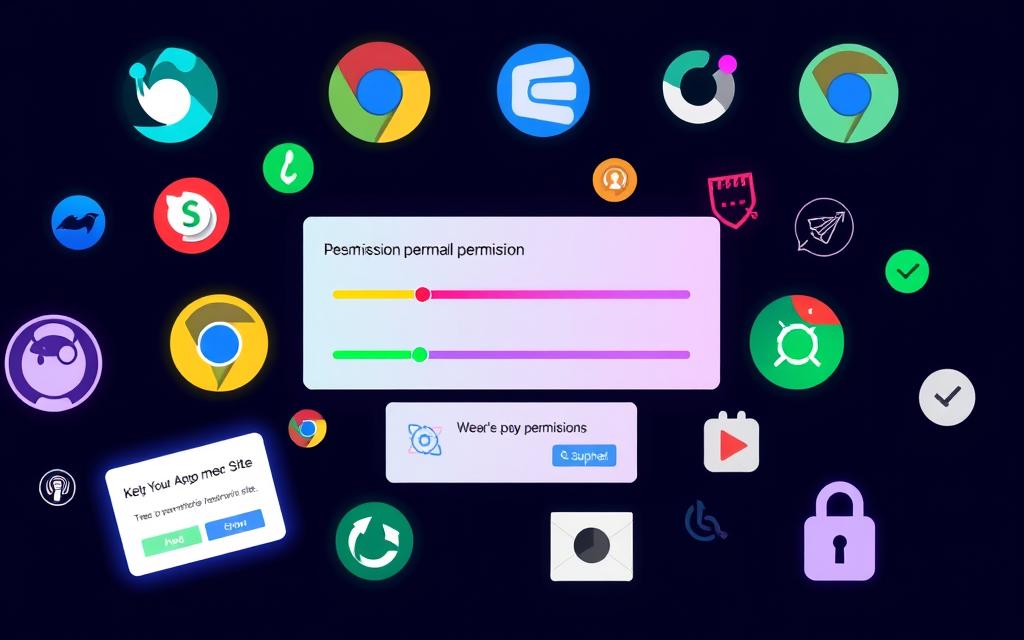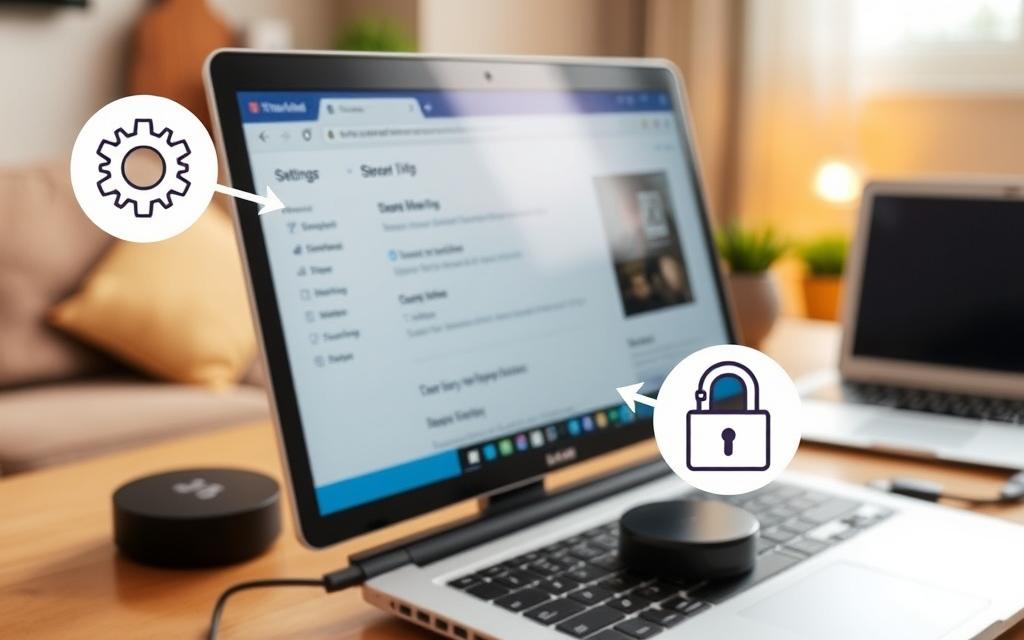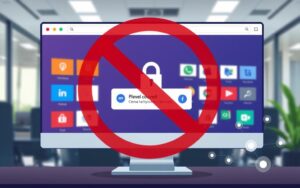Table of Contents
Today, entertainment is just a click away, but sometimes you hit a snag. Many find it tricky to get past streaming permissions, blocking the fun. Studies show that most people allow permissions once or tweak them as needed. This guide gives you straightforward steps to enjoy streaming on your PC without trouble.
Understanding Site Permissions
Site permissions are key to how we use websites. They decide what a website can do on your device. This affects your online experience. By changing these in the settings, you can control things like camera use, sharing your location, and getting notifications.
Modern browsers like Google Chrome (version 74 upwards) and Microsoft Edge (from version 79) let users control these permissions. For example, they can turn on access for cameras and screen recording. But, Safari on macOS doesn’t let users do this. Those using Stream for video need to pick a screen before recording each time. This shows the importance of managing these permissions well.
Below is a detailed table showcasing the various permissions that can be modified on websites:
| Permission Type | Description |
|---|---|
| Cookies | Control over cookies used by the site. |
| Microphone | Access to the device’s microphone for audio input. |
| Camera | Permission for camera usage, essential for video functions. |
| Location | Enables websites to request the user’s geographical location. |
| Notifications | Allows websites to send notifications to the user. |
| Background Sync | Permits the site to sync data when online. |
| Pop-Ups and Redirects | Control over the appearance of pop-ups and redirects. |
| Ads | Management of advertisement display preferences. |
| Automatic Downloads | Control over automatic download requests from the site. |
| Augmented/Virtual Reality | Access to device features for AR and VR applications. |
| File Editing | Allows sites to request permissions for editing files. |
| Payment Handlers | Enables sites to process payments securely. |
Understanding and adjusting site permissions can make browsing better. It helps keep your privacy and security. Adjusting these settings to fit your needs gives you a more personalised web experience.
Importance of Allowing Streaming Sites
Letting streaming sites onto your PC brings lots of benefits. It greatly improves how you interact with the site. For instance, through live streaming, you can join in on discussions and activities as they happen.
This craving for high-quality streams leads to a need for platforms that are both diverse and perform well.
Moreover, having access to streaming services means getting content that feels like it was picked just for you. By visiting certain sites, you get recommendations that fit your taste. This helps you discover movies, shows, and live events in huge libraries.
Being part of this makes the experience much richer for both viewers and content makers.
To keep enjoying these services without a hitch, following the platform’s rules is key. Make sure you have the right permissions to avoid pauses in your streaming. This keeps your watching experience smooth, whether it’s live or on-demand.
The growth of streaming culture has changed how we use media. It shows how important it is to know how to make the most of these platforms.
| Feature | Benefits |
|---|---|
| Live Streaming | Enables real-time viewer interaction |
| Personalised Content | Tailored recommendations based on preferences |
| Event Access | Watch events as they happen without delays |
| Content Variety | Access to a large and diverse range of media |
| Community Building | Fosters interactions among users with similar interests |
How to Allow a Streaming Site on Your PC
To enjoy streaming on your PC, learn to navigate Chrome’s settings. Adjusting these helps manage site permissions. A well-set browser boosts streaming and improves your experience.
Accessing Chrome Settings
Start by opening Chrome. Click the menu icon (three vertical dots) at the top right. Then click ‘Settings,’ and go to ‘Privacy and security.’ Here, you’ll find options to tweak your settings. This is where you can manage site permissions.
Managing Site Permissions
In the site permissions section, you can see and change permissions for websites. You can allow or block access as you like. You control permissions for cookies, JavaScript, pop-ups, and notifications. Make sure your favourite streaming sites have the right permissions set.
Allowing Specific Features
For interactive streams, enabling the camera and microphone is key. You can let a site use these features temporarily or for future visits. You’ll see this option when a site asks for access. Adjusting these settings makes your streaming smooth. For more tips, check out this comprehensive guide.
Setting Permissions in Different Browsers
Changing browser permissions is key for a smooth experience on streaming sites. Every browser offers unique settings for these permissions. This allows you to control the access to things like cameras and microphones. Next, we’ll look at how to configure these settings in popular browsers such as Google Chrome, Firefox, and Edge.
Google Chrome Configuration
Follow these steps to adjust permissions in Google Chrome:
- Open Google Chrome and click on the three dots in the upper right corner.
- Select Settings from the dropdown menu.
- Go to Privacy and security and click on Site settings.
- Under Permissions, change settings for the camera and microphone as necessary.
Note that streaming sites might not work right if camera or microphone access is blocked. Video call issues could also occur if these are not turned on.
Firefox Permission Management
Managing site permissions in Firefox is simple for a customized browsing experience:
- Hit the menu button at the top right and choose Preferences or Settings.
- Look for Privacy & Security to find the settings you need.
- Under Permissions, click Settings by the camera or microphone options.
- Decide to Allow or Block permissions for specific sites.
In Firefox, you can see current permission setups by clicking the permission icon in the address bar. This browser even lets you set custom permissions. This gives you more control over your streaming.
Edge Browser Settings
Adjusting permissions in Microsoft Edge is easy:
- Open Edge and click on the three dots at the top right.
- Pick Settings and go to Cookies and site permissions.
- Click on Camera or Microphone to see settings for specific sites.
- Change permissions as needed.
In Edge, managing permissions is a lot like in Chrome. It makes sure users can enjoy streaming sites fully. If access is denied, some site features might not work.
| Browser | Access Method | Camera/Microphone Permissions | Custom Options |
|---|---|---|---|
| Google Chrome | Settings > Privacy and security > Site settings | Manage under Permissions | No custom options |
| Firefox | Menu > Preferences > Privacy & Security | Allow/Block for individual sites | Custom permissions for each site |
| Edge | Settings > Cookies and site permissions | Manage under Camera/Microphone | No custom options |

Dealing with Pop-Ups and Redirects
Working with pop-ups and redirects helps improve your streaming. Google Chrome usually blocks pop-ups. But, you might see some due to malware or allowed notifications. Knowing this helps you enjoy streaming without interruptions.
You can adjust pop-up settings in Chrome. This lets you control what pops up on your screen. Blocking notifications from certain sites also makes streaming smoother.
In places like work or school, network bosses control the pop-up settings on Chrome devices. This keeps the online experience steady for everyone. Chrome filters out unwanted pop-ups, making things more convenient.
Website owners can look at the Abusive Experience Report to fix pop-up problems. This helps make sure their site doesn’t annoy visitors with too many ads. Given we spend about 19 hours a week watching online videos, cutting down on ads is crucial. We run into up to 10,000 ads every day, highlighting the need to manage pop-ups well.
Pop-up ads come in different types, such as pop-unders and overlays. Streaming services like Netflix, Amazon Prime, and Disney+ usually don’t have pop-ups. This is not the same for free streaming sites, where ads are more frequent. A pop-up blocker, like Poper Blocker, can stop these ads. It blocks not just pop-ups but banners and other ad types too.
Changing browser settings to block pop-ups on movie sites can help. But, using a pop-up blocker is usually more effective. This way, you avoid distractions and enjoy movies or TV shows more.
Understanding Third-Party Cookies
When you browse the web, it’s important to know about third-party cookies. They’re used by sites you visit for ads and tracking your online activity. These cookies come from other domains, not the one you’re on. This knowledge can help you protect your privacy and improve your streaming.
What are Third-Party Cookies?
Third-party cookies are trackers that gather your data across different websites. They are different from first-party cookies, which the site you’re on stores. They collect info on your visits, likes, and buys. Advertisers use this data to show you ads that might interest you. While this can make ads more relevant, it can also lead to privacy worries.
Managing Cookies for Streaming
To keep your streaming private, managing cookies is key. Here’s how:
- Use browser settings to stop third-party cookies.
- Try Consent Management Platforms like CookieScript for easy cookie control.
- Clear your browsing history and cookies often for a fresh start.
- Use tools like Google Tag Manager for better cookie control.
By doing these, you can keep necessary cookies for streaming but block the tracking ones. This way, you get to keep your streaming personal and your browsing private.
| Type of Cookie | Purpose | Privacy Impact |
|---|---|---|
| First-Party Cookies | They make your site experience better. | These are usually safe. |
| Third-Party Cookies | They track you across sites for ads. | This can make some users worried about privacy. |
| Second-Party Cookies | Shared with partners for certain site features. | The impact depends on the sites’ agreement. |
Troubleshooting Common Issues
Streaming can sometimes fall into annoying problems. Effective troubleshooting is key to fixing these problems for a better viewing. We discuss ways to fix common issues, like clearing the cache, resetting permissions, and updating the browser.
Clearing Browser Cache
Clearing your browser cache is often the first step. A full cache may keep old data, causing websites to not load properly. Here’s how to clear it:
- Go into your browser settings.
- Find and select the option to clear browsing data.
- Make sure to remove cached images and files.
- Confirm to completely clear the cache.
After clearing the cache, restart the browser. This usually fixes many playback issues.
Resetting Site Permissions
Bad site behaviour? Resetting site permissions might help. Sometimes, permission changes can impact streaming. Here’s how you reset:
- Find privacy settings in your browser.
- Look for the permissions section.
- Change all permissions back to their original settings.
Resetting permissions can solve streaming hiccups, letting sites work right.
Checking Browser Updates
It’s important to keep your browser updated. Updates fix problems and add new features. To update your browser:
- Open the browser menu.
- Click on ‘About’ or ‘Help’.
- Update if it tells you to.
An updated browser often means better streaming. It can improve how websites function.
Conclusion
Knowing how to manage site permissions is key for smooth streaming on your PC. It helps you watch without hold-ups. This advice is especially crucial as many now choose live video over old-school TV.
Today, 80% of people would rather watch live videos than read blogs. Setting up your browser right enhances your viewing. It keeps you connected to interesting content without breaks. So, remember, a better setup means more fun watching online media.
Video is the top choice for content now, keeping viewers glued longer than text does. For tips on starting a successful live-streaming site, go to this resource. Using these methods, you’ll engage more with streaming. And, you’ll make your watching experience way better.
FAQ
How do I change site permissions on my browser?
To update your site permissions, first go to your browser’s settings. Look for ‘Privacy and Security’. Then, click on ‘Site Settings’. It’s here that you can handle permissions for different sites, like camera use, getting notifications, and sharing your location.
Why is it important to allow streaming sites access?
Allowing streaming sites to access certain features can make your experience better. You’ll get to enjoy live chats, content made just for you, and instant updates. This creates a more engaging and fun streaming time.
What should I do if I am experiencing pop-ups during streaming?
If pop-ups are bothering you, tweak your browser’s settings to stop them. Also, check that you’ve set the streaming site’s permissions correctly. This way, you’ll stop unwanted pop-ups.
Can I manage third-party cookies while streaming?
Yes, managing third-party cookies is possible in your browser’s settings. Allow cookies that are necessary but block the ones that track you. This will help keep your privacy safe while you stream.
What troubleshooting steps should I take if the video won’t load?
If your video isn’t loading, first try to clear your browser’s cache. Then, reset the permissions for sites to their original settings. Also, check that your browser is up to date. This helps with compatibility issues.
How do I ensure my streaming permissions comply with platform guidelines?
Check regularly the permissions you have given to the streaming service. Refer to the service’s help centre for rules on permission. This will help keep your streaming smooth and without interruptions.
Is there a way to allow all features for a specific streaming site?
Yes. To let a streaming site use all features, adjust its permissions in your settings. Allow it to access your camera, microphone, and notifications among others. This will ensure you get the full experience.









